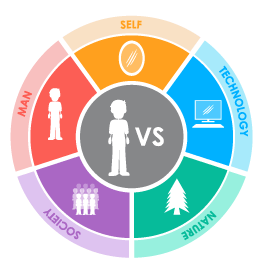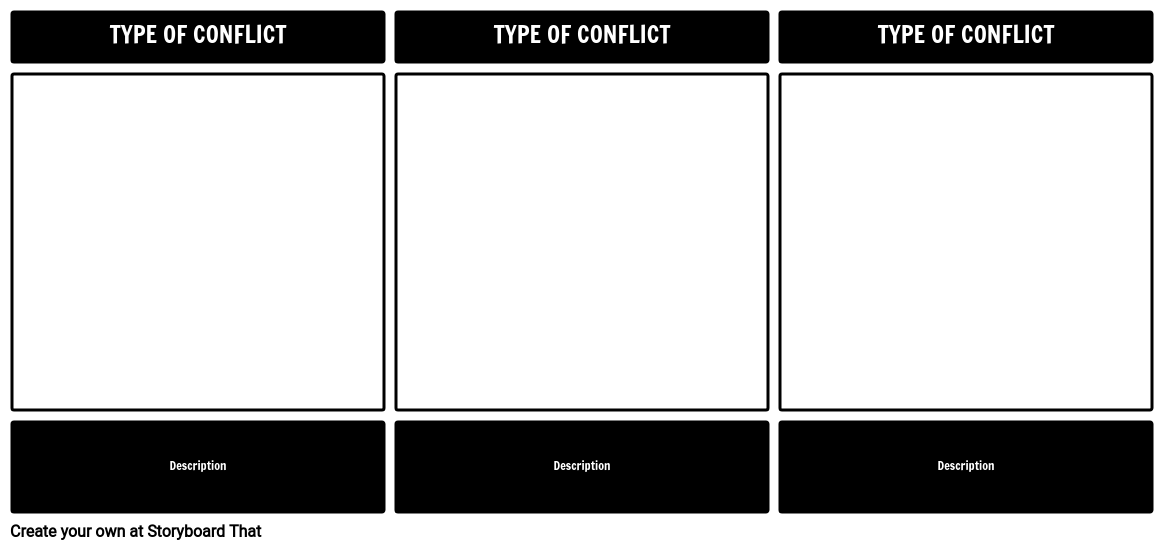Lesson Plan Overview
Literary conflicts are often taught during ELA units. Building on prior knowledge to achieve mastery level with our students is important. An excellent way to focus on the various types of literary conflict is through storyboarding. Having students choose an example of each literary conflict or moral dilemma and depict it using the storyboard creator is a great way to reinforce your lesson!
In To Kill a Mockingbird, conflict is not only present, but it is a very apparent element. Much of the conflict arises from the prejudices of the people of Maycomb.
Examples of To Kill a Mockingbird Conflict
MAN vs. SELF: The Sheriff vs. Himself
When Boo kills Ewell, the sheriff must decide whether to lie, or to arrest Boo. He decides to call the incident an accident, and that Ewell fell on his knife. The decision to lie was a struggle for the Sheriff. If he arrested Boo, it would have been like killing a mockingbird.
MAN vs. SOCIETY: Atticus vs. Racism in Maycomb
A prime example of a man vs. society is when Atticus agrees to defend Tom Robinson. Members of the town feel Atticus should not defend Tom because he is black, and the novel is set in a time of racial discrimination. Atticus is looked upon poorly, threatened, and even harassed, for being Tom’s Lawyer.
MAN vs. MAN: Bob Ewell vs. Boo Radley.
At the conclusion of the novel, Ewell goes after Scout and Jem on their way home. To save them, Boo leaves his house and kills Ewell in a fight.
Template and Class Instructions
(These instructions are completely customizable. After clicking "Copy Activity", update the instructions on the Edit Tab of the assignment.)
Student Instructions
Create a storyboard that shows at least three forms of literary conflict in To Kill a Mockingbird.
- Identify conflicts in To Kill a Mockingbird.
- Categorize each conflict as Character vs. Character, Character vs. Self, Character vs. Society, Character vs. Nature, or Character vs. Technology.
- Illustrate conflicts in the cells, using characters from the story.
- Write a short description of the conflict below the cell.
Lesson Plan Reference
Student Rubric
(You can also create your own on Quick Rubric.)
| Proficient | Emerging | Beginning | Try Again | |
|---|---|---|---|---|
| Conflict Identification | Student identifies correct major conflicts and uses strong, clear textual evidence to support choice. | Student identifies correct major conflict and uses few or unclear details to support their choice. | Student identifies incorrect major conflict, and uses some details from the text to support their choice. | Student does not attempt to identify major conflict or identifies incorrect major conflict with no explanation. |
| Understanding Outcome | Student clearly shows the outcome of the conflict and its effects on the protagonist with evidence from the text. | Student shows the outcome of the conflict and its effect on the protagonist, but some evidence is unclear. | Student shows the outcome of the conflict, but does not examine its effect on the protagonist and uses some vague textual evidence. | Student does not clearly show the outcome of the conflict or use textual evidence. |
| Character | Storyboard includes all required characters and clearly names them. Goes above and beyond by adding additional details. | Storyboard includes all required characters and clearly names them. | Storyboard includes protagonist and antagonist but leaves out other required characters. | Storyboard does not include the names of required characters. |
| Storyboard | Student clearly shows effort to convey the setting the scene of the book | Student attempts to convey setting and scene of the book, but lacks some clarity. | Student does not clearly convey the setting and scene. | Student makes little or no attempt to convey the setting or scene. |
| Spelling and Grammar | Student uses exemplary spelling and grammar. There are no errors. | Student makes a minor error in spelling and grammar. | Student makes several minor errors in spelling and grammar. | Student makes many errors in spelling and grammar; little attempt at spellchecking. |
Lesson Plan Overview
Literary conflicts are often taught during ELA units. Building on prior knowledge to achieve mastery level with our students is important. An excellent way to focus on the various types of literary conflict is through storyboarding. Having students choose an example of each literary conflict or moral dilemma and depict it using the storyboard creator is a great way to reinforce your lesson!
In To Kill a Mockingbird, conflict is not only present, but it is a very apparent element. Much of the conflict arises from the prejudices of the people of Maycomb.
Examples of To Kill a Mockingbird Conflict
MAN vs. SELF: The Sheriff vs. Himself
When Boo kills Ewell, the sheriff must decide whether to lie, or to arrest Boo. He decides to call the incident an accident, and that Ewell fell on his knife. The decision to lie was a struggle for the Sheriff. If he arrested Boo, it would have been like killing a mockingbird.
MAN vs. SOCIETY: Atticus vs. Racism in Maycomb
A prime example of a man vs. society is when Atticus agrees to defend Tom Robinson. Members of the town feel Atticus should not defend Tom because he is black, and the novel is set in a time of racial discrimination. Atticus is looked upon poorly, threatened, and even harassed, for being Tom’s Lawyer.
MAN vs. MAN: Bob Ewell vs. Boo Radley.
At the conclusion of the novel, Ewell goes after Scout and Jem on their way home. To save them, Boo leaves his house and kills Ewell in a fight.
Template and Class Instructions
(These instructions are completely customizable. After clicking "Copy Activity", update the instructions on the Edit Tab of the assignment.)
Student Instructions
Create a storyboard that shows at least three forms of literary conflict in To Kill a Mockingbird.
- Identify conflicts in To Kill a Mockingbird.
- Categorize each conflict as Character vs. Character, Character vs. Self, Character vs. Society, Character vs. Nature, or Character vs. Technology.
- Illustrate conflicts in the cells, using characters from the story.
- Write a short description of the conflict below the cell.
Lesson Plan Reference
Student Rubric
(You can also create your own on Quick Rubric.)
| Proficient | Emerging | Beginning | Try Again | |
|---|---|---|---|---|
| Conflict Identification | Student identifies correct major conflicts and uses strong, clear textual evidence to support choice. | Student identifies correct major conflict and uses few or unclear details to support their choice. | Student identifies incorrect major conflict, and uses some details from the text to support their choice. | Student does not attempt to identify major conflict or identifies incorrect major conflict with no explanation. |
| Understanding Outcome | Student clearly shows the outcome of the conflict and its effects on the protagonist with evidence from the text. | Student shows the outcome of the conflict and its effect on the protagonist, but some evidence is unclear. | Student shows the outcome of the conflict, but does not examine its effect on the protagonist and uses some vague textual evidence. | Student does not clearly show the outcome of the conflict or use textual evidence. |
| Character | Storyboard includes all required characters and clearly names them. Goes above and beyond by adding additional details. | Storyboard includes all required characters and clearly names them. | Storyboard includes protagonist and antagonist but leaves out other required characters. | Storyboard does not include the names of required characters. |
| Storyboard | Student clearly shows effort to convey the setting the scene of the book | Student attempts to convey setting and scene of the book, but lacks some clarity. | Student does not clearly convey the setting and scene. | Student makes little or no attempt to convey the setting or scene. |
| Spelling and Grammar | Student uses exemplary spelling and grammar. There are no errors. | Student makes a minor error in spelling and grammar. | Student makes several minor errors in spelling and grammar. | Student makes many errors in spelling and grammar; little attempt at spellchecking. |
How To Discuss the Ethical Dilemmas Faced in Literary Conflicts
Introduce Ethical Dilemmas
Start with defining ethical dilemmas, which are instances where characters must make moral decisions between two options that are incompatible but both have ethical repercussions. Teachers can give students a few examples of ethical dilemmas that everyone faces in daily life.
Give Context
Give the story the required background information, such as the characters, the scene, and the events that led up to the conflict. Define and give examples of different types of literary conflicts in literature such as character vs self or character vs character.
Discuss Morality and Practicality
Encourage students to assess the character's moral convictions against practical reasons when evaluating morality vs. practicality. Discuss whether morality or necessity is given priority by characters. Students can also discuss their experiences with situations where they had to choose morality over practicality or vice-versa and give their reasoning for doing so.
Discuss Consequences
Identify different types of ethical dilemmas faced by characters in the story and examine the probable short- and long-term effects of each decision as you discuss the outcomes. Encourage students to consider how possible outcomes might affect the character and the course of the story.
Encourage Respectful Debate
Establish a respectful, welcoming climate in the classroom where students can express their differing opinions. Stress the value of productive discourse and active listening.
Frequently Asked Questions About Literary Conflict in To Kill a Mockingbird
How do the internal struggles of the characters impact the story as a whole?
The internal problems of the characters give their depictions depth and reality. For instance, Scout's internal battle to comprehend Boo Radley shows how she has changed from being innocent to comprehending. These internal tensions add to the intricacy of the story's themes by reflecting the more significant societal concerns.
How does the character Atticus Finch represent conflict in the book?
Through his person vs. society conflict, Atticus Finch serves as an example of conflict. The locals are against him and criticize him for protecting Tom Robinson, a black guy who is charged with raping a white woman. Atticus' unshakable commitment to justice and moral integrity put him at odds with the prejudiced culture he lived in.
How does the Tom Robinson case illustrate multiple forms of conflict?
A complex and multi-layered conflict is represented by Tom Robinson's trial. It pits one person against another (Atticus against the prosecution), one person against society (Tom Robinson against racial prejudice), and one person against oneself (each juror's internal battle with their own prejudices). The little social conflicts that exist in Maycomb are reflected in this trial.
More Storyboard That Activities
To Kill a Mockingbird
Testimonials

“By using the product, they were so excited and they learned so much...”–K-5 Librarian and Instructinal Technology Teacher

“I'm doing a Napoleon timeline and I'm having [students] determine whether or not Napoleon was a good guy or a bad guy or somewhere in between.”–History and Special Ed Teacher

“Students get to be creative with Storyboard That and there's so many visuals for them to pick from... It makes it really accessible for all students in the class.”–Third Grade Teacher
© 2025 - Clever Prototypes, LLC - All rights reserved.
StoryboardThat is a trademark of Clever Prototypes, LLC, and Registered in U.S. Patent and Trademark Office










